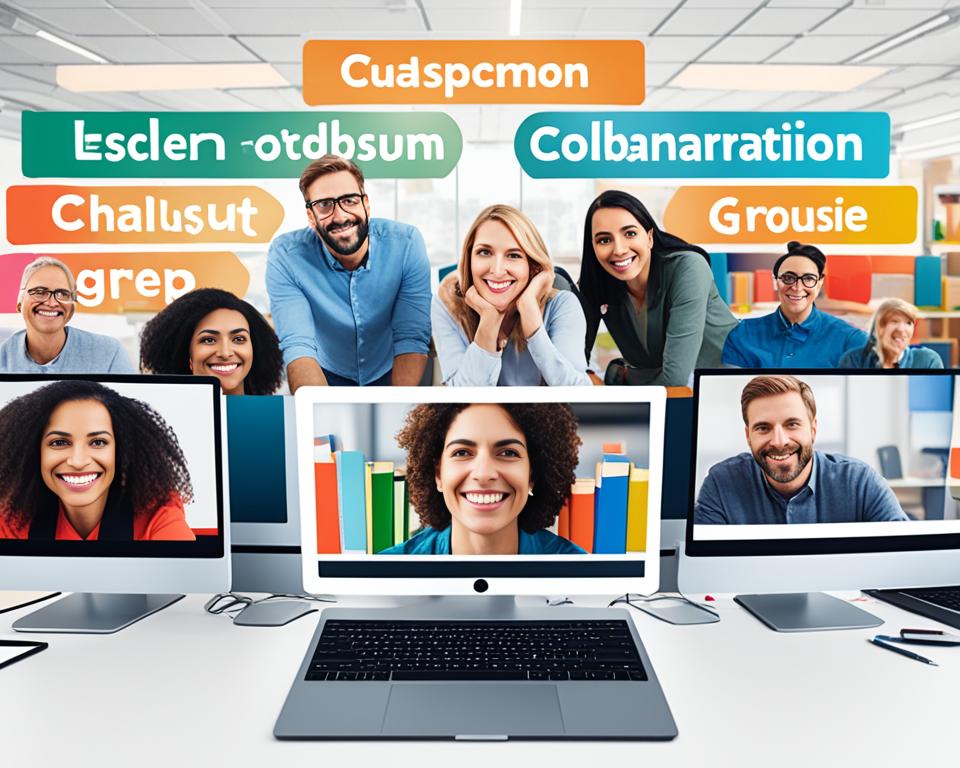In today’s fast-paced world, interactive e-learning sessions have become increasingly popular. With the rise of online learning platforms and virtual classrooms, learners now have access to a wide range of interactive learning tools and e-learning software. These tools create a virtual learning environment that promotes active and engaging learning experiences. Whether it’s blended learning, online education, or distance learning, interactive e-learning solutions are transforming the way we learn.
However, not all online courses are created equal. Many learners find traditional e-learning courses to be dry and unengaging. To truly captivate learners and ensure effective learning, it’s crucial to incorporate interactive elements, use multimedia, make courses mobile-friendly, personalize the learning experience, use real-life scenarios, and provide opportunities for feedback.
Key Takeaways:
- Interactive e-learning sessions offer engaging and effective learning experiences.
- Incorporate interactive elements like quizzes, games, and simulations to promote active participation.
- Use multimedia such as images, videos, and animations to enhance the learning experience.
- Ensure courses are mobile-friendly for flexible and accessible learning.
- Personalize the learning experience to cater to individual preferences and industry-specific needs.
Incorporate Interactive Elements for Engaging Learning
One way to ensure learner engagement in e-learning is to incorporate interactive elements into the courses. These interactive elements can include quizzes, games, simulations, and other activities that allow learners to actively participate in the learning process.
By incorporating interactive elements, the learning experience becomes more interesting and engaging for the learners. They are actively involved in the learning process, which helps them retain information better and enhances their overall understanding of the subject matter.
For example, quizzes at the end of each module can reinforce the key points covered in the lesson. Learners can test their knowledge and apply what they’ve learned. This not only helps them assess their understanding but also provides an opportunity for reinforcement and practice.
Furthermore, games and simulations that simulate real-life scenarios can be highly effective in engaging learners and helping them apply the concepts they’ve learned. These interactive activities create a safe and controlled environment for learners to practice their skills and gain practical experience.
Through active participation in these interactive elements, learners are more likely to remain engaged throughout the learning process, leading to a more effective educational experience.
Here’s an example of an interactive quiz that can be incorporated into an e-learning course:
Quiz: Test Your Knowledge
- What are the benefits of incorporating interactive elements in e-learning?
- a. Improved engagement and retention rates
- b. Enhanced understanding and application of concepts
- c. Increased motivation and enjoyment
- d. All of the above
Which interactive element allows learners to actively practice their skills?
- a. Quizzes
- b. Games
- c. Simulations
- d. All of the above
How can interactive elements contribute to the learning process?
- a. By making the learning experience more engaging
- b. By helping learners retain information better
- c. By providing opportunities for reinforcement and practice
- d. All of the above
Incorporating interactive elements like quizzes, games, simulations, and other activities is an effective way to engage learners and enhance the overall learning experience. It promotes active participation, reinforcing key concepts, and enabling learners to apply what they’ve learned in real-life scenarios.
Continue reading to discover the benefits of incorporating multimedia elements to further enhance the learning experience.
Use Multimedia to Enhance Learning Experience
Text-heavy e-learning courses can be tedious and unengaging. To enhance the learning experience, it is important to incorporate multimedia elements such as images, videos, animations, and audio clips. Multimedia not only makes the courses more interesting and engaging but also helps reinforce key concepts. For example, a video demonstrating a concept can make it easier for learners to understand, and an animation showing a process can make it more memorable. Multimedia elements can also create an emotional connection with learners, increasing their engagement with the material.
By integrating multimedia into e-learning courses, learners can benefit from a visually appealing and interactive experience. Images allow for visual representation of concepts, making them easier to comprehend and remember. Videos provide a dynamic medium for delivering information, capturing learners’ attention while effectively conveying complex ideas. Animations offer a unique way to illustrate processes or actions, allowing learners to visualize concepts in a simplified and engaging manner. Furthermore, the use of audio clips can provide additional context and explanations, further enhancing the learning experience.
The strategic use of multimedia not only stimulates multiple senses but also caters to different learning styles. Visual learners can better absorb information through images and videos, while auditory learners can benefit from audio clips and spoken explanations. By catering to diverse learning preferences, multimedia elements create a more inclusive and effective learning environment.
In addition to enhancing understanding and retention, multimedia elements also foster an emotional connection with learners. Emotional engagement is key to motivating learners and promoting active participation. For example, an image depicting a relatable real-life scenario can evoke emotions and create a stronger connection with the content. Similarly, a video testimonial from a subject matter expert can inspire learners and generate a sense of credibility and relevance.
Integrating multimedia elements also allows for reinforcement of key concepts. By presenting information in different formats and through various media, learners can revisit and review important topics from different perspectives. This repetition and reinforcement help solidify understanding and improve information retention.
In conclusion, the use of multimedia elements in e-learning courses brings numerous advantages. From images and videos to animations and audio clips, multimedia enhances the learning experience by engaging learners, reinforcing key concepts, and creating emotional connections. By incorporating multimedia strategically, instructors can create more dynamic and effective e-learning courses that cater to diverse learning styles and foster deeper understanding and retention.
Make Courses Mobile-Friendly for Flexibility and Accessibility
In today’s mobile-first world, it is crucial to optimize e-learning courses for mobile devices. This means designing courses with a responsive layout that adjusts to different screen sizes.
Mobile-friendly courses allow learners to access them on the go, increasing flexibility and accessibility. By providing a seamless experience across devices, learners can easily engage with the content anytime, anywhere.
A responsive layout ensures that the course adapts to various screen sizes, whether it’s a smartphone, tablet, or desktop computer. This flexibility allows learners to comfortably view and interact with the course regardless of the device they are using.
Swipe or tap gestures can be implemented to navigate through the course, providing a user-friendly experience that mimics the interaction patterns people are familiar with on their mobile devices.
By making courses mobile-friendly, e-learning providers not only cater to the needs of their learners but also enhance their overall User Experience (UX).
Additionally, voice-activated interactions can be incorporated into the mobile learning experience, allowing learners to navigate through the course or perform actions using voice commands. This hands-free approach further enhances accessibility and convenience for learners on the go.
Designing courses with a mobile-first approach also encourages a focused User Experience (UX) by simplifying content and prioritizing the most important information for smaller screens. This ensures that learners can easily absorb and comprehend the content without feeling overwhelmed.
Furthermore, a mobile-friendly course doesn’t compromise functionality. Features such as quizzes, interactive activities, and multimedia elements can still be effectively integrated into the mobile learning experience.
To summarize, making courses mobile-friendly with a responsive layout, swipe or tap navigation, voice-activated interactions, and a user-focused design enhances the overall accessibility and flexibility of e-learning. By prioritizing mobile optimization, e-learning providers can deliver an engaging and seamless learning experience across various devices.
| Benefits of Mobile-Friendly Courses | Examples |
|---|---|
| Flexibility and accessibility | Learners can access courses on the go, at their convenience. |
| Enhanced User Experience (UX) | Optimized layout and swipe/tap navigation offer a seamless learning experience. |
| Convenience of voice-activated interactions | Learners can navigate and interact with the course using voice commands, providing hands-free accessibility. |
| Focused learning experience | Designing courses with a mobile-first approach ensures content is streamlined for smaller screens, improving comprehension. |
Personalize the Learning Experience for Better Engagement
When it comes to e-learning, personalization is key to enhancing learner engagement. Giving learners the ability to choose their learning path or customize the content based on their preferences can significantly increase their connection to the material. By tailoring the learning experience to their specific needs and interests, learners are more likely to stay engaged and retain information.
One way to achieve personalization in e-learning is by incorporating real-world examples that are relevant to the learner’s specific industry or job role. This allows learners to see how the concepts they are learning apply to their own professional context, making the content more meaningful and applicable.
For example, imagine an e-learning course on sales techniques. Instead of using generic examples, the course can include scenarios that mirror real-life sales situations in the learner’s specific industry. This not only enhances their understanding of the material but also motivates them to apply the knowledge gained in their day-to-day work.
Choose Your Learning Path
A great way to personalize the learning experience is by giving learners the option to choose their own learning path. This means providing different modules or sections that cover various topics or skill levels, and allowing learners to select the ones that align with their goals and interests. By giving learners control over their learning journey, they feel more invested and engaged in the process.
Customize Content to Fit Your Needs
Another strategy for personalization is to allow learners to customize the content to fit their specific needs. This can include providing options for adjusting the pace of the course, selecting different formats (such as text, audio, or video), or even enabling learners to skip content they are already familiar with. Customizing the content helps learners focus on what is most relevant to them, making the learning experience more efficient and enjoyable.
Real-World Examples for Relevance
By incorporating real-world examples into e-learning courses, learners can better connect with the material. Real-world examples help learners see the practical application of the concepts being taught, making the content more relevant and memorable. For example, in a cybersecurity course, using specific examples of data breaches in the learner’s industry can emphasize the importance of the topics being covered and highlight the potential consequences of inadequate security measures.
| Benefits of Personalization in E-Learning |
|---|
| 1. Increased learner engagement |
| 2. Improved retention of information |
| 3. Enhanced relevance and applicability of the content |
| 4. Increased motivation to learn |
Personalization in e-learning is not only beneficial for learners but also for organizations. By providing a customized learning experience, organizations can ensure that their employees receive training that is directly relevant to their roles and responsibilities, leading to improved performance and productivity.

By personalizing the learning experience through the choice of learning path, customized content, and real-world examples, e-learning can become more engaging and effective. Learners feel more connected to the material, retain information better, and are motivated to apply their knowledge in practical settings.
Use Real-Life Scenarios to Apply Learning
Incorporating real-life scenarios into e-learning courses is an effective way to engage learners and help them apply what they’ve learned. By simulating common situations relevant to the course topic, learners can practice their skills in a safe and controlled environment. Real-life scenarios allow learners to see how the concepts they are learning apply to real-world situations, improving their retention and confidence in applying the knowledge in their own lives.
Applying learned concepts to real-life scenarios is crucial for practical application and skill development. It allows learners to bridge the gap between theory and practice, gaining hands-on experience in a controlled setting. By presenting learners with realistic challenges and situations, they can actively apply their knowledge and practice essential skills, preparing them for real-world situations.
Real-life scenarios provide learners with a safe environment to make mistakes and learn from them before encountering similar situations in the real world. This safe space encourages experimentation and fosters a growth mindset, enabling learners to refine their skills and enhance their problem-solving abilities.
In addition to increased practical application, real-life scenarios stimulate critical thinking and creativity. Learners are prompted to analyze complex situations, consider multiple perspectives, and make informed decisions. This process enhances their decision-making skills and expands their problem-solving capabilities, equipping them with the skills necessary for success in their respective fields.
By using real-life scenarios in e-learning courses, learners are provided with meaningful, relevant, and engaging content that resonates with their everyday experiences. This personalized approach enhances the overall learning experience and ensures that learners are equipped with the skills and knowledge required to navigate real-world challenges with confidence.
To illustrate the effectiveness of using real-life scenarios, consider the table below, which highlights the benefits of applying learned concepts in a safe and controlled environment:
| Benefits of Using Real-Life Scenarios |
|---|
| Enhanced practical application and skill development |
| Safe space for making mistakes and learning from them |
| Stimulated critical thinking and creativity |
| Improved decision-making and problem-solving abilities |
| Relevant and engaging learning experience |
Incorporating real-life scenarios in e-learning courses provides learners with the opportunity to apply their knowledge and practice essential skills within a safe and controlled environment. By simulating real-world situations, learners can enhance their practical application, critical thinking, and decision-making abilities, ultimately improving their overall learning experience. The next section will explore another important aspect of interactive e-learning: providing opportunities for feedback.
Provide Opportunities for Feedback to Enhance Learning
Feedback is an essential component of the learning process. It helps learners gauge their understanding of the material and provides motivation for improvement. By incorporating feedback mechanisms into e-learning courses, instructors can create a more interactive and effective learning experience.
“Feedback is the breakfast of champions.” – Ken Blanchard
Learners benefit from various forms of feedback, such as quizzes and assessments, that allow them to assess their progress. These tools help learners identify areas for improvement and reinforce their understanding of the material. Regular feedback leads to greater engagement and improved retention rates.
Quizzes and Assessments
Quizzes and assessments play a vital role in fostering learning progression. They enable learners to assess their knowledge and understanding of the course content. Regular quizzes not only help gauge understanding but also provide an opportunity for learners to reinforce their learning through repetition. They offer learners a chance to test their knowledge and identify any gaps that need to be addressed.
Assessments, on the other hand, provide a more comprehensive evaluation of learners’ skills and knowledge. They allow for a deeper understanding of the material and enable instructors to assess the effectiveness of their teaching methodologies.
Motivation and Reinforcement
Feedback acts as a powerful motivator for learners. Positive feedback acknowledges their progress and encourages continued engagement. It fosters a sense of accomplishment and fuels the desire to achieve even more. Conversely, constructive feedback helps learners identify areas for improvement and provides guidance on how to enhance their understanding.
Through feedback, instructors reinforce the importance of the material and guide learners toward deeper comprehension. By reinforcing correct answers and providing explanations for incorrect ones, instructors ensure that learners understand the concepts thoroughly. Reinforcement helps learners retain knowledge and reinforces their confidence in their abilities.
The Importance of Feedback in E-Learning
Feedback is integral to the success of e-learning courses. It enhances the learning experience by enabling learners to measure their understanding, motivating them to further engage with the material and reinforcing their progress. Incorporating feedback mechanisms, such as quizzes and assessments, into e-learning courses creates a dynamic and interactive learning environment that promotes effective learning.
By providing opportunities for feedback, instructors empower learners to take an active role in their learning journey. They promote a growth mindset and create a supportive environment where learners can thrive.
Feedback is essential for enhancing learning and creating a more interactive e-learning experience. It helps learners gauge their understanding, provides motivation for improvement, and reinforces their progress. Incorporating feedback mechanisms into e-learning courses is crucial for promoting engagement, retention, and overall success.
The Benefits of Interactive Training
Interactive training provides learners with numerous advantages, resulting in an enhanced learning environment that fosters creativity, improved decision-making through mindful practice, reinforcement of learning through feedback, higher levels of engagement, greater retention rates, increased motivation, and improved learning efficiency. Incorporating interactive elements and utilizing technologies like virtual reality and augmented reality can significantly enhance the learning experience, making it more engaging, effective, and enjoyable.
Enhanced Learning Environment
Interactive training creates an environment that promotes creativity and critical thinking. By actively engaging in the learning process, learners are encouraged to explore ideas, test assumptions, and develop innovative solutions. The interactive nature of the training stimulates learners’ curiosity and encourages them to think beyond traditional boundaries.
Improved Decision-Making through Mindful Practice
Interactive training allows learners to practice making decisions in real-life scenarios. By applying their knowledge and skills in a simulated environment, learners can gain valuable experience and develop their decision-making abilities. This mindful practice helps learners become more confident in their decision-making and prepares them to handle similar situations in the real world.
Reinforcement of Learning through Feedback
Interactive training provides learners with immediate feedback on their performance. Whether through quizzes, assessments, or interactive exercises, learners receive instant validation or guidance on their understanding of the material. This reinforcement of learning helps learners solidify their knowledge and identify areas for improvement, ensuring a more effective learning experience.
Higher Engagement and Greater Retention
The interactive nature of the training captures learners’ attention and actively involves them in the learning process. By providing opportunities for active participation, such as interactive activities and simulations, learners are more likely to stay engaged and retain the information presented. The hands-on approach to learning ensures that learners are actively involved and invested in the training material.
Increased Motivation
Interactive training sparks learners’ motivation by making the learning experience enjoyable and rewarding. The use of gamified elements, challenges, and rewards keeps learners motivated to progress and achieve their learning goals. When learners are motivated, they are more focused and dedicated to the learning process, resulting in a deeper understanding and retention of the material.
Increased Learning Efficiency
Interactive training optimizes the learning process by providing learners with targeted and relevant content. It allows learners to interact with the material at their own pace, focusing on areas that require more attention. This personalized approach to learning enhances learning efficiency by maximizing the use of learners’ time and ensuring that they acquire the necessary knowledge and skills effectively.
Overall, interactive training offers a wide range of benefits that contribute to a more effective and engaging learning experience. By incorporating interactive elements and leveraging interactive technologies, learners can have a transformative learning journey, resulting in improved knowledge acquisition, better decision-making skills, and a higher level of engagement and motivation.
What is Interactive Learning?
Interactive learning, also known as participative learning, involves active engagement from learners in their own learning process. It goes beyond the traditional passive learning approach by encouraging learners to make decisions, solve problems, and be mindful of their intentions. This interactive approach fosters critical thinking, decision-making skills, and problem-solving abilities.
In interactive learning, learners are provided with opportunities to engage with the material, make choices, and receive immediate feedback. This active participation enhances their understanding and retention of the content. Rather than being passive recipients of information, learners become active participants in their educational journey.
“Interactive learning empowers learners to take ownership of their education and develop essential skills through hands-on experiences.” – Educational expert
By actively engaging with the material, learners are able to apply theoretical knowledge to real-life situations. This application of concepts further enhances their understanding and allows for practical skill development. Additionally, the decision-making and problem-solving aspects of interactive learning empower learners to think critically and confidently tackle challenges in various domains.
Interactive learning also takes into account the learner’s intent. Learners are encouraged to set goals, reflect on their progress, and adjust their learning strategies accordingly. By being aware of their intentions and objectives, learners become active agents in their own educational journey and are motivated to achieve their learning goals.
Benefits of Interactive Learning:
Interactive learning offers numerous benefits for learners:
- Enhanced engagement: Interactive learning captures learners’ attention and keeps them actively involved in the material.
- Improved retention: By actively participating in the learning process, learners retain information more effectively.
- Enhanced critical thinking: Interactive learning encourages learners to think critically, analyze information, and make informed decisions.
- Increased problem-solving skills: Through interactive activities, learners develop problem-solving skills that can be applied to real-life situations.

With the increasing popularity of online education and e-learning platforms, interactive learning has become an essential component of effective digital instruction. The integration of interactive elements, such as quizzes, simulations, and interactive multimedia, further enhances the learning experience and promotes active engagement.
Through interactive learning, learners are empowered to take control of their education, develop essential skills, and achieve their learning goals. By creating an environment that promotes active participation, decision-making, problem-solving, and learner intent, interactive learning sets the stage for a transformative educational experience.
Conclusion
Creating interactive e-learning sessions that are both engaging and effective is crucial for a successful learning experience. By incorporating interactive elements, such as quizzes, games, and simulations, learners can actively participate and apply their knowledge. The use of multimedia, such as images, videos, and animations, enhances the learning experience and reinforces key concepts.
Making courses mobile-friendly ensures flexibility and accessibility, allowing learners to engage with the material anytime, anywhere. Personalization, through the use of real-life scenarios and customization options, helps learners connect with the content on a deeper level. Providing opportunities for feedback empowers learners to gauge their understanding and make improvements.
The benefits of interactive training are vast. It creates an enhanced learning environment, improves decision-making skills, increases engagement, and boosts retention rates. Learners are motivated to participate actively, resulting in increased efficiency and learning outcomes. In embracing the interactive learning approach, learners can unlock their full potential and have a truly engaging and effective learning experience.
FAQ
What are some tips for creating effective and engaging e-learning courses?
To create effective and engaging e-learning courses, it is important to incorporate interactive elements, use multimedia, make courses mobile-friendly, personalize the learning experience, use real-life scenarios, and provide opportunities for feedback.
How can interactive elements enhance learner engagement in e-learning?
Interactive elements such as quizzes, games, simulations, and other activities allow learners to actively participate in the learning process, making it more interesting and engaging. Interactive elements also help learners retain information better.
How can multimedia enhance the learning experience in e-learning courses?
By incorporating multimedia elements such as images, videos, animations, and audio clips, e-learning courses become more interesting, engaging, and help reinforce key concepts. Multimedia elements also create an emotional connection with learners.
Why is it important to make e-learning courses mobile-friendly?
In today’s mobile-first world, optimizing e-learning courses for mobile devices is crucial. Mobile-friendly courses allow learners to access them on the go, increasing flexibility and accessibility.
How does personalization improve learner engagement in e-learning?
Personalizing the learning experience by allowing learners to choose their learning path or customize the content based on their preferences makes them feel more connected to the material. Incorporating real-world examples relevant to the learner’s industry or job role also enhances engagement.
Why should real-life scenarios be incorporated into e-learning courses?
Real-life scenarios allow learners to practice their skills in a safe environment and apply the concepts they’ve learned. By simulating common situations, learners can see how the concepts apply to real-world situations, improving their retention and confidence.
How does feedback contribute to the effectiveness of e-learning?
Feedback provides learners with opportunities to gauge their understanding of the material, identify areas for improvement, and reinforce their progress. Regular feedback helps motivate learners and enhances their engagement and retention.
What are the benefits of interactive training?
Interactive training offers benefits such as an enhanced learning environment that fosters creativity, improved decision-making through mindful practice, reinforcement of learning through feedback, higher levels of engagement, greater retention rates, increased motivation, and increased learning efficiency.
What is interactive learning?
Interactive learning is participative learning where learners actively engage in the learning process, making decisions, solving problems, and being mindful of their intentions. It allows learners to engage with the material, make choices, and receive immediate feedback, enhancing their understanding and retention of the content.
How can I create engaging and effective e-learning sessions?
To create engaging and effective e-learning sessions, incorporate interactive elements, use multimedia, make courses mobile-friendly, personalize the learning experience, incorporate real-life scenarios, provide opportunities for feedback, and embrace the interactive learning approach.





